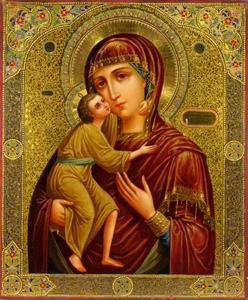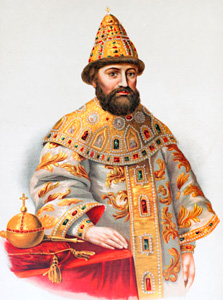On March 27th (14th by the old calendar the Church commemorates the Feodorovskaya-Kostroma icon of the Mother of God.
Tradition holds this icon to be of great antiquity. It is not known by whom or when this icon was brought to Russia, but already in the early 12th century it was standing in a chapel near the city of Kitezh. Prince George Vsevolodovich wanted to move the icon from the chapel to the city, but the icon refused to be moved. Bowing down before the will of the Mother of God, Prince George built the Gorodetsky monastery on that site. During the subsequent invasion of the Tatar khan Batyy, the monastery burned down and was left in ruins. But amid this destruction the holy icon remained miraculously untouched and appeared again.

Prince Vasily of Kostroma, the younger brother of holy Prince Alexander Nevsky, became lost in the forest while hunting game. This was in 1239. He saw an icon standing amid one of the spruces, but when he tried to take it down, it rose up in the air. Amazed by such a wondrous occurrence, Prince Vasily returned to the city and told the clergy and the people of his vision. Everyone went out to the forest and, in truth, found the icon in the indicated spot and fell to their knees in prayer to the Mother of God. The clergy then took the icon and carried it to the church. The inhabitants of Kostroma observed that while the prince was hunting in the forest, a warrior in rich armor came up to the city with an icon in his hands. The warrior looked like the image of the Great Martyr Theodore Stratilatus, in whose honor the Kostroma Cathedral was consecrated, and for this reason the icon was called Feodorovskaya. One time several people living in the vicinity of the Gorodetsky monastery that had been destroyed by the Tatars came to Kostroma, and they immediately recognized the cathedral icon that used to be in their church.
When the Kostroma Cathedral burned down, the icon was found in the ashes undamaged. It was then richly adorned and placed in the reconstructed cathedral.
In 1260 a Tatar invasion threatened the city of Kostroma with total destruction. The inhabitants and the prince placed all their hope of salvation in the Mother of God. The Prince of Kostroma took the Feodorovskaya icon from the cathedral and carried it all around the troops, while the priests served molebens along the way. When the two armies came together, a great miracle occurred: blinding rays of light, brighter and hotter than the sun’s, shone forth from the miraculous icon, blinding and burning the Tatars, who fled in great fear.
The Kostroma cathedral burned down again, but when the people rushed to save the icon, they found it in the air above the flames of the fire. The people, fearing that the Mother of God wanted to take the icon away from the city for their sins, entreated the Theotokos for forgiveness. The icon descended, supported by an invisible force, right in the middle of the town square. Soon a separate stone church was built for it.

One of the major events in Russian history – the election of Mikhail Fedorovich Romanov to the throne in 1613 – is tied in with the Feodorovskaya icon. A ceremonious delegation composed of the clergy, noblemen, and people of all stations was sent from Moscow to Kostroma. In Kostroma the delegation, which arrived with the miraculous Vladimir icon of the Mother of God and an icon of the holy Muscovite hierarchs, was met by the local clergy with the Feodorovskaya icon, and together they all went to the Ipatyev monastery, where the young Mikhail lived with his mother, the eldress Martha.
The delegation pleaded with Mikhail to take the throne. Mikhail initially declined such a heavy burden, while his mother absolutely refused to let him go, and for a long time remained unyielding. Finally the head of the delegation took the Vladimir icon and the icon of the Muscovite hierarchs and firmly said to her: “For what purpose did these icons of the Holy Lady and the Muscovite wonder-workers travel with us on such a long journey? If you do not listen to us, then for the sake of the Mother of God and the great hierarchs yield to mercy and do not anger the Lord God.” The eldress Martha fell to her knees before the Feodorovskaya icon and said: “May Thy will be done, Mistress! Into Thy hands I commend my son: instruct him in the true path, for his own good and the good of the homeland!” In this manner Mikhail was forced to concede, and straightaway he was proclaimed a ruling Sovereign.
In commemoration and on the day of this event, March 14th, an annual celebration was established. Tsar Mikhail Fedorovich took a copy of this icon with him to Moscow and placed it in his palace chapel. In general, he worshipped the Fedorovskaya icon with great piety; in 1636 he had the icon repainted and richly adorned, and granted many privileges to the Kostroma Cathedral.
From the Feodorovskaya icon of the Mother of God there issued a multitude of miracles and healings. In 1834 Lieutenant-General Ilovaysky arrived in Kostroma to venerate the Feodorovskaya icon, and he told of a miracle that had happened to his grandfather, a Cossack chief. He was captured by Caucasian tribesmen. While he languished in captivity, it was revealed to him in a dream that he would receive deliverance by the grace of the Feodorovskaya icon, and he was commanded to flee. He escaped, hid a while in the hollow of a tree, and afterwards walked a distance of nearly 400 miles, constantly saying the troparion of the Feodorovskaya icon along the way. Finally, after overcoming incredible hardships en route, he safely returned to his native city of Cherkessk and soon afterwards went on a pilgrimage to Kostroma to venerate the Feodorovskaya icon.
In 1913 Kostroma became the center of festivities in honor of the 300th anniversary of the House of the Romanovs and the renaissance of Russian state-hood. Churches dedicated to the Feodorovskaya Mother of God were built in honor of this jubilee in St. Petersburg and in Tsarskoye Selo (the “Tsar’s cathedral”); the Imperial family often prayed in this latter church.
|